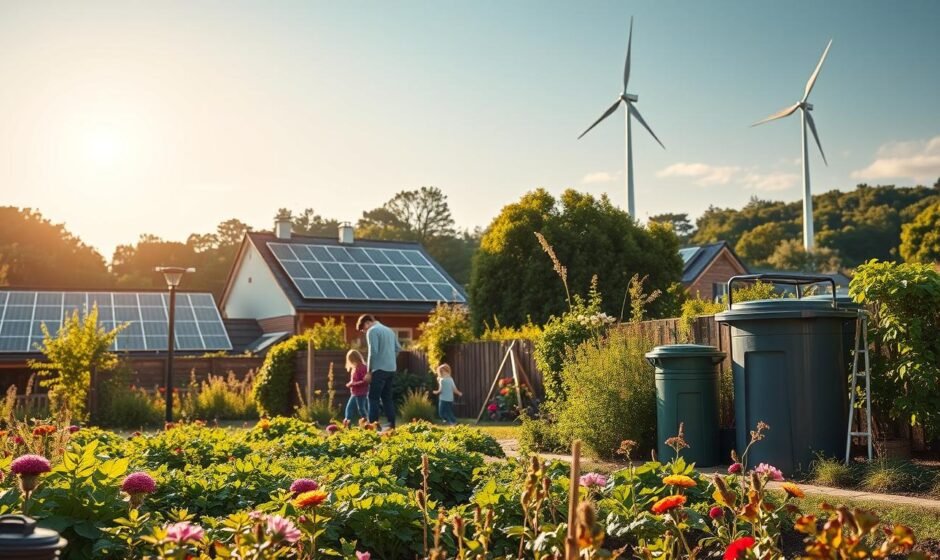Did you know that about 15% of all human-caused greenhouse gas emissions come from livestock? Nearly two-thirds of these emissions are from cattle. This shows how our daily choices affect the environment. It’s vital to adopt sustainable living to cut down our carbon footprint and fight climate change.
By making smart choices in our lives, we can help the planet. This includes using less energy at home, choosing eco-friendly transport, eating greener, and managing waste better. Understanding and changing our habits can make a big difference. Let’s look at simple ways to live sustainably and make the world a better place for all.
Key Takeaways
- Lowering your water heater temperature to 120˚F can help reduce energy consumption.
- Unplugging appliances and avoiding standby mode can save significant energy.
- Switching to energy-efficient products and light bulbs can drastically lower carbon emissions.
- Engaging in a plant-based diet can substantially reduce your environmental impact.
- Practising water conservation techniques can lead to substantial fossil fuel savings in water heating.
- Community involvement amplifies efforts to promote sustainable living and environmental protection.
Understanding Your Carbon Footprint
Climate change is a big worry, and understanding carbon emissions is key. The carbon footprint shows how our daily actions affect the environment. It helps us see how much we contribute to greenhouse gases.
What Is a Carbon Footprint?
A carbon footprint is a way to measure how much we impact climate change. It’s about the carbon dioxide we release. The United Nations says it’s about our direct and indirect actions that add to greenhouse gases.
Big things like energy use and how we travel are major contributors. For example, in the U.S., homes are responsible for about 20% of all greenhouse gas emissions.
Why It Matters
The importance of carbon footprint is huge, as more people learn about climate issues. What we do can really help reduce greenhouse gases. By choosing greener options, we can make a big difference.
Using public transport can cut our carbon footprint by 45% compared to driving alone. Eating more plant-based foods can also lower our footprint by up to 50%. This shows how our food choices affect the planet.
Energy Conservation at Home
Using energy-saving tips at home can really help. Small changes can make a big difference. This is true for using energy-efficient lighting and managing your appliances.
Switching to LED Lighting
Switching to LED bulbs is a great way to cut down on energy use. Incandescent bulbs waste a lot of energy as heat. LEDs, on the other hand, use up to 80% less energy.
They also last a lot longer. This means you save money on bills and reduce waste in landfills.
Unplugging Appliances
Many appliances use power even when not in use. This can cost you extra money. Unplugging devices or using smart power strips helps control energy use.
This simple change can help a lot. It reduces energy waste and supports home energy conservation. For more tips, check out this resource.
| Lighting Type | Energy Consumption (per bulb) | Average Lifespan | Environmental Impact |
|---|---|---|---|
| Incandescent | 60 Watts | 1,000 hours | High waste and CO2 emissions |
| CFL | 13-15 Watts | 8,000 hours | Moderate waste and CO2 emissions |
| LED | 8-12 Watts | 25,000+ hours | Low waste and CO2 emissions |
These comparisons show the LED lighting benefits. They help you save energy and money. Investing in LED bulbs makes your home more sustainable.
Sustainable Transportation Options
Choosing sustainable transport is key to cutting down carbon emissions and making travel greener. Options like biking, walking, carpooling, and using public transport are great. They help the environment and improve your life.
Benefits of Biking and Walking
Biking or walking for short trips is good for your health and the planet. They have almost no impact on the environment. Plus, they don’t use fossil fuels, making them very eco-friendly.
Cars, on the other hand, produce a lot of CO2, over 285 grams per kilometre. Switching to biking or walking is a big step towards a cleaner future.
Carpooling and Public Transit
Carpooling and public transport are also good choices. Public transport like buses and trains use less CO2 per person than cars. Carpooling can cut emissions in half, showing the power of travelling together.
Buses, while often using fossil fuels, can emit less CO2 when full. Switching to these options not only reduces environmental harm but also saves money. You could save around £1,000 a year by being more fuel-efficient.
Eating a Plant-Based Diet
Switching to a plant-based diet can greatly reduce your carbon footprint. It also improves your health and the planet’s. By eating less meat and choosing local foods, you can live more sustainably.
Reducing Meat Consumption
Choosing a diet with less meat can cut down your carbon footprint a lot. Studies show a vegan diet can reduce carbon impact by up to 73%. Meat, like beef, produces a lot of methane, a harmful gas.
By eating less meat, you help the planet and save resources. Meat takes a lot more water to produce than plants. So, eating plants is better for water too.
Local vs. Imported Foods
While plant-based diets are good, think about where your food comes from. Eating local foods cuts down on emissions from transport. It also helps local businesses thrive.
Choosing seasonal, local produce is even better. It needs less energy and produces fewer emissions. So, eating locally and seasonally is a win-win for you and the planet.
Water Conservation Techniques
Water conservation is key to sustainable living. Only 3% of Earth’s water is freshwater, and only 0.5% is drinkable. It’s vital to use water wisely to help the planet.
This section will explore ways to save water. We’ll look at practical methods and why they’re important for our planet.
Fixing Leaks and Drips
Fixing leaks in your home is a big step towards saving water. Even small drips can waste up to 15 litres a day. This adds up and wastes a lot of water.
By fixing leaks quickly, you save water and cut down on energy costs. This means lower bills and less harm to the environment.
Rainwater Harvesting
Rainwater harvesting is another way to save water. It collects and reuses rainwater, reducing the need for treated water. This helps protect our freshwater resources.
This method also cuts down on costs for water treatment and lowers carbon emissions. With the right system, you can help the environment while saving water.
Eco-Friendly Home Products
Choosing the right products for your home is key to living sustainably. Using eco-friendly items cuts down on waste and makes your home healthier. This guide will help you pick out green cleaning supplies and furniture that’s good for the planet.
Choosing Green Cleaning Supplies
Choosing green cleaning products is essential for a clean, safe home. Regular cleaners can harm your air and health. Eco-friendly options are safer and better for the planet, reducing waste and pollution.
Sustainable Furniture Options
Think about the environment when picking furniture. Sustainable furniture is made from materials that last and are good for the planet. Look for items made from reclaimed wood or bamboo. These choices not only look great but also help protect our forests and reduce waste.

| Type of Product | Eco-Friendly Option | Benefits |
|---|---|---|
| Cleaning Supplies | Plant-based cleaners | Non-toxic, biodegradable, safe for children and pets |
| Furniture | Reclaimed wood furniture | Reduces waste, unique designs, supports sustainability |
| Textiles | Organic cotton and linen | Pesticide-free, breathable, reduces chemical exposure |
| Home Décor | Natural fibre rugs | Breathe easier, sustainably sourced, durable |
Zero-Waste Lifestyle Essentials
Living zero-waste is key for a greener future. It means saying no to single-use plastics and composting food waste. These steps help the planet and save you money too.
Refusing Single-Use Plastics
Getting rid of single-use plastics is vital. They harm our planet for centuries. Using reusable items cuts down waste a lot.
The zero-waste market is growing fast. It’s because more people want to change their ways. Choosing durable over disposable is a big step.
Composting Organic Waste
Composting is good for everyone. It turns food and garden waste into useful soil. This cuts down landfill waste by up to 30%.
It also helps your garden grow better. Plus, growing your own food saves money. It’s good for the planet and your wallet.
| Practice | Impact on Waste | Financial Savings |
|---|---|---|
| Refusing Single-Use Plastics | Reduces plastic pollution | Long-term savings on disposable products |
| Composting | Decreases waste sent to landfills | Less spent on waste disposal |
| Meal Planning | Minimises food waste | Savings from better utilisation of ingredients |
| Buying Second-Hand | Reduces consumption of new products | Average savings of around £1,000 annually |
Adopting zero-waste living helps our planet and improves your lifestyle. It might seem hard, but small changes make a big difference.
Supporting Renewable Energy
Using renewable energy is key to fighting climate change and creating a green future. By picking cleaner options, you cut down on harmful emissions and protect our planet. Solar and wind power help local economies and health, tackling global issues too.
Benefits of Solar Power
The benefits of solar energy are clear and strong. Over 75 percent of global emissions come from fossil fuels, making solar a big step forward. The cost of solar power has dropped by 85 percent from 2010 to 2020, making it a smart choice for homes.
Switching to solar cuts down on greenhouse gases and creates jobs. For every dollar in renewable energy, three times as many jobs are made compared to fossil fuels. This sector is expected to add 14 million clean energy jobs by 2030, boosting the economy.
Community Wind Projects
Joining community wind initiatives shows your dedication to green energy. These projects let communities invest in and enjoy local wind power. The cost of onshore wind has fallen by 56 percent in ten years, making it affordable for many.
These projects improve air quality and lower health costs from pollution. With more investment in renewables, up to 65 percent of electricity could come from green sources by 2030. For more on living sustainably and renewable energy, check out this resource.
Sustainable Fashion Choices
In recent years, fashion has moved towards being more sustainable. This change helps consumers make better choices, reducing the industry’s carbon footprint. Choosing sustainable fashion is good for both you and the planet. By exploring thrift shopping and eco-friendly brands, you can make your wardrobe more sustainable.
Thrift Shopping and Upcycling
Thrift shopping lets you find unique, second-hand items. It also helps the environment by reducing new clothing demand. The fashion industry is a big polluter, with 10% of global carbon emissions coming from it.
By choosing second-hand, you help reduce waste. This tackles the problem of fast fashion’s overproduction and disposal.

Upcycling adds to your sustainable fashion choices. It lets you get creative and give old items a new life. This not only extends the life of textiles but also supports sustainable consumerism.
Upcycling helps tackle the fashion industry’s environmental challenges. Every second, a garbage truck’s worth of clothing is thrown away, often made from non-biodegradable materials.
Choosing Eco-Friendly Brands
Choosing eco-friendly brands is key when buying new clothes. Brands like Reformation and Stella McCartney focus on being green. For example, Reformation has been carbon neutral for years and aims to recycle 75% of its waste.
Buying from these brands supports a more sustainable fashion industry. Learning about their practices helps you make better choices.
Researching brands with clear CSR policies is also important. This lets you buy clothes that match your values. You can start making your wardrobe more sustainable by focusing on thrift shopping and eco-friendly brands. Learn more about embracing sustainability in your fashion choices.
Gardening for Sustainability
Gardening is key to making our planet greener. Urban gardening, in particular, offers many benefits. It gives us fresh food and brings people together. By growing native plants, we can make our gardens better for the future.
Benefits of Urban Gardening
Urban gardening makes communities stronger and food more secure. It cuts down on carbon emissions from food transport. If all UK gardeners planted one tree, it could save a lot of carbon.
Using kitchen scraps for compost helps the environment. It reduces landfill waste and makes our gardens healthier. Composting can even cut down CO2 emissions.
Using Native Plants
Native plants are great for gardens. They need less water and care than others. This saves water and helps local wildlife.
Choosing native plants also cuts down on emissions from transport. Techniques like rainwater harvesting help even more. They can save a lot of water from a small roof.
| Gardening Practice | Environmental Impact |
|---|---|
| Urban Gardening | Enhances biodiversity and food security |
| Composting | Reduces landfill waste and CO2 emissions |
| Native Plants | Lower water requirements and improved local biodiversity |
| Rainwater Harvesting | Reduces reliance on municipal water sources |
Mindful Consumption Habits
Adopting mindful consumption habits is key for a sustainable lifestyle. Making conscious choices helps you understand the benefits of minimalism and the brand transparency importance. This not only helps the environment but also improves your life quality.
Importance of Minimalism
Minimalism teaches you to buy only what you need, reducing waste. It focuses on durable, quality products over disposable ones. Studies show that one well-made item can replace three to five cheaper ones, saving money.
In 2023, 64% of people worldwide worried about climate change. But, price often stops them from buying sustainably. Investing in quality items may cost more upfront but saves money in the long run. Online stores now offer more eco-friendly and fair-trade products, making sustainable choices easier.
Researching Brand Transparency
Knowing where your products come from connects your purchases to your values. Mindful consumption involves researching brands for their transparency. Choosing brands that share your ethical beliefs supports a sustainable economy and helps communities.
Understanding minimalism and brand transparency empowers you to live more sustainably. This philosophy changes how you consume and contributes to a greener future.
| Aspect | Minimalism | Brand Transparency |
|---|---|---|
| Waste Reduction | Up to 30% reduction in household waste | Informed purchasing choices leading to sustainable support |
| Financial Benefits | Long-term savings through durable products | Trust in ethical production methods enhances consumer loyalty |
| Environmental Impact | Lower carbon footprint through mindful purchases | Encourages brands to maintain sustainable practices |
Community Involvement and Advocacy
Getting involved in community environmental projects is key to a sustainable future. Joining local groups raises awareness of big ecological problems. It also encourages action in your area. Working with these groups lets you have a bigger say in environmental policies.
These efforts not only help fight climate change but also bring people together. They strengthen the bonds within our communities.
Joining Local Environmental Groups
Being part of local environmental groups can make a big difference. In Edinburgh, for example, groups like Networking Key Services and the Edinburgh Lothian Regional Equality Council run workshops. They focus on making Asian restaurants more sustainable.
These workshops show how important it is to work together. They help different communities adopt green practices.
Volunteering for Clean-Up Events
Helping out at clean-up events is another great way to contribute. The 2 Minute Foundation has inspired over 80,000 people to pick up litter. This has brought communities closer and improved people’s health.
By volunteering, you help make your area look better. You also learn about important environmental issues. It’s a chance to be part of a bigger effort for a greener future. For more eco-friendly ideas, check out sustainable landscaping and other projects.




